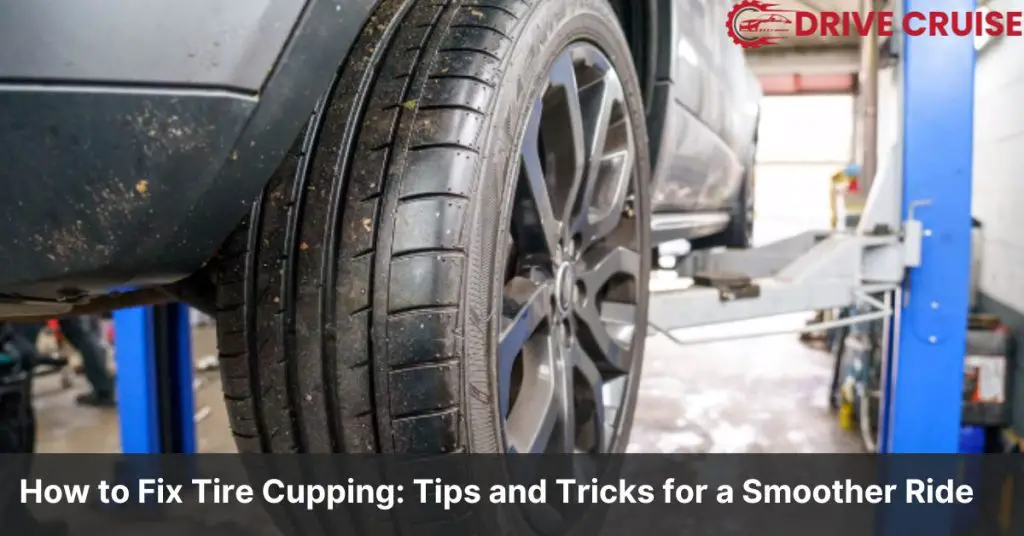That rhythmic thump-thump-thump emanating from your wheels can be a real buzzkill. If you’ve noticed uneven tire wear or diagonal grooves across your tire tread, it’s likely that your tires are experiencing cupping. Fortunately, this issue can be fixed, and you may not need to replace your tires entirely. In this guide, we’ll explore how to fix tire cupping and provide valuable insights into the causes behind this issue.
Tire cupping is a form of tire wear that results in uneven displacement on the road’s surface. This wear pattern can be caused by a variety of factors, including improper inflation, worn suspension components, or misalignment. Cupping can also be a symptom of tire balance problems or a bent wheel. In the following sections, we’ll delve into effective repair strategies and provide tips for preventing this issue in the future.
If left unaddressed, tire cupping can lead to a host of problems, including excessive tire noise, a rough ride, and decreased stability on the road. Fortunately, there are several steps you can take to fix this issue and get your tires back in top shape. Whether you need to rebalance your tires or address underlying suspension issues, this guide has you covered.
Understanding Tire Cupping
If you’ve noticed an uneven wear pattern on your tires, you may be experiencing tire cupping. Cupping refers to an irregular wear pattern on the tire tread, characterized by scalloped sections with deeper grooves and raised areas between them.
Tire cupping can be caused by a variety of factors, including:
- Worn or faulty shock absorbers: If your shock absorbers are worn or faulty, they can cause your tires to bounce up and down, leading to cupping.
- Misaligned wheels: Misaligned wheels can cause your tires to wear unevenly, leading to cupping.
- Worn suspension components: Worn suspension components can cause your tires to bounce and wear unevenly, leading to cupping.
- Improper inflation: Too much or too little air in your tires can cause them to wear unevenly, leading to cupping.
To prevent tire cupping, it’s important to maintain proper tire inflation and have your wheels aligned regularly. If you notice any signs of cupping, such as a rough ride or uneven wear, it’s important to have your tires and suspension system inspected by a professional.
In severe cases, tire cupping may require professional tire shaving or even replacing the tires entirely. So, it’s important to address the issue as soon as possible to avoid further damage to your tires and suspension system.
Why Does My Car Have Tire Cupping?
If you’ve noticed diagonal grooves across your tire tread, your tires may be cupping. Cupping is an uneven tire wear pattern that can be caused by a variety of issues. Here are some common culprits behind uneven tire wear:
Misalignment Issues
Incorrect wheel alignment can cause uneven tire wear on the edges. Improper toe or camber can contribute to cupping. Additionally, incorrect caster can also lead to cupping. Worn or damaged suspension components like ball joints, tie rods, or control arms can affect wheel alignment and lead to cupping.
Tire Imbalance
Tires with uneven weight distribution or inconsistencies from side to side can cause a bouncing effect, leading to cupping. This can be caused by static or dynamic imbalance.
Other Potential Causes
Improper inflation can put undue stress on specific areas of the tread, accelerating uneven wear. Underinflated or overinflated tires can cause cupping. Manufacturing defects or internal tire separations can also cause irregular wear patterns.
It’s important to address the underlying cause of cupping to prevent further damage and ensure your safety on the road. By identifying and fixing the issue, you can extend the life of your tires and improve your driving experience.
Fixing Tire Cupping: Is It Possible?
If you notice that your tires have cupping or uneven wear, you may be wondering if it is possible to fix them. The answer depends on the severity of the cupping.
Minor Cupping:
If you have minor cupping, there are a few things you can do to fix it:
- Tire Rotation and Rebalancing: Regularly rotating tires can help distribute wear more evenly. Rebalancing ensures proper weight distribution to minimize cupping.
- Tire Shaving (Professional Service): In some cases, a professional tire shaving can remove a small amount of rubber to smooth out minor cupping.
Severe Cupping:
If you have severe cupping, you may need to replace your tires. Severe cupping can affect the structural integrity of the tire, which can be dangerous. It’s important to have your tires inspected by a professional to determine if replacement is necessary.
Preventing Future Tire Cupping
Tire cupping is an irregular wear pattern that can cause noise and vibration while driving. Preventing future tire cupping is essential to avoid unexpected repairs and expenses. Here are some steps you can take to prevent tire cupping:
Regular Maintenance
Regular maintenance checks should include wheel alignment inspections and tire rotations. Proper wheel alignment ensures that the tires wear evenly and prevent cupping. Tire rotations help distribute wear evenly across all four tires, reducing the risk of cupping on any one tire.
Balanced Tires
Ensure tires are balanced during rotations or after repairs that disturb wheel balance. Imbalanced tires can cause cupping on the tires, especially if the imbalance is severe. A qualified mechanic can balance your tires to prevent cupping.
Addressing Underlying Issues
If cupping persists, have a qualified mechanic diagnose and repair any underlying suspension or steering problems. Worn suspension components, misalignment, and other issues can cause tire cupping. Addressing these problems promptly can prevent future cupping and prolong the life of your tires.
Inspecting Tires Regularly
Regularly check your tires for signs of uneven wear, cracks, or bulges. Cupping is a form of irregular wear that can indicate other problems with your tires or vehicle. Inspecting your tires regularly can help you catch cupping early and prevent further damage.
Conclusion
In conclusion, tire cupping is a common issue that can affect the performance and safety of your vehicle. By understanding the causes and solutions for tire cupping, you can take control of this issue and extend the lifespan of your tires.
Regular maintenance is key to preventing tire cupping. Ensure that your tires are properly inflated, rotate them regularly, and maintain your suspension system. If you notice any unusual wear patterns on your tires, have them inspected by a professional mechanic.
Addressing underlying problems such as misaligned wheels, worn-out suspension components, and unbalanced tires can also help prevent tire cupping. Additionally, practicing preventive measures such as avoiding hard braking, accelerating smoothly, and avoiding potholes and rough roads can help reduce the risk of tire cupping.
Related Posts:
- Can You Drive a Right Hand Drive Car in the US? Everything You Need to Know
- Car Overheating: Causes and Solutions for Normalization
- Chassis Control System Error: Causes and Solutions
- Ford Focus: Years to Avoid for a Smoother Ride
- How to fix chassis control system fault: A beginner’s guide
- How to Fix Tire Cupping: Tips and Tricks for a Smoother Ride
- Lexus RX 400h Problems: What You Need to Know
- Nissan Forward Emergency Braking Warning Light Reset: A Quick Guide
- Nissan Qashqai Malfunction Warning Light: What You Need to Know
- Toyota Corolla Gear: A Guide to Understanding Your Car’s Transmission
- Yokohama Geolandar AT G015 Review: A Reliable All-Terrain Tire














